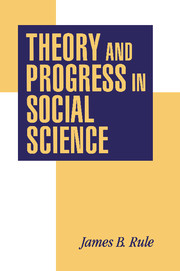PART III
Published online by Cambridge University Press: 05 November 2011
Summary
In the study of ideas, as at the movies, the best seats are not always closest to the action. In the preceding chapters, I have sought to develop a measure of useful distance from the theoretical visions considered there.
The result has perhaps conveyed the feeling mentioned in Chapter 2 – that of experiencing an optical illusion. Up close, each model of closure, each theoretical program generates a powerful sense of accomplishment and intellectual direction. Each seems, at least to its proponents, to meet the most pressing of intellectual needs, to chart precisely the most crucial aspects of the subject matter – to “move the field forward,” to increase our overall grasp of what really matters in social life. In short, to represent an unmistakable instance of intellectual progress.
From greater distance, such impressions are less powerful, more qualified. What appear as dramatic accomplishments to enthusiasts of the moment are apt to seem banal, pedestrian, or even embarrassing from the vantage point of other times and constituencies. The theoretical progress so painstakingly traced by working out the implications of the theory may appear, from such a view, as obsession with points of obscure or dubious import. The empirical researches inspired by such theoretical programs may well seem like nothing more than elaborate efforts to document and analyze facts that no one needed to know in the first place.
Information
- Type
- Chapter
- Information
- Theory and Progress in Social Science , pp. 171 - 172Publisher: Cambridge University PressPrint publication year: 1997
